![]()
![]()
![]()
Use LEFT and RIGHT arrow keys to navigate between flashcards;
Use UP and DOWN arrow keys to flip the card;
H to show hint;
A reads text to speech;
39 Cards in this Set
- Front
- Back
|
What is the primary difference between eukaryotic and prokaryotic cells?
|
Eukaryotic cells are subdivided into enclosed compartments - called organelles.
|
|
|
What are ribosomes
|
Made in the nucleolus, and leave nucleus and enter cytoplasm. Involved in protein synthesis.
1) Membrane bound ribosomes - |
|
|
What are membrane-bound ribosomes?
|
They are attached to cytoplasmic surface of ER membrane (rough ER).
They synthesize proteins that are translocated to ER and then to gogli. |
|
|
What are free ribosome?
|
These are unattched to any membrance and synthesize all other proteins:
Nuclear proteins Mitochondrial proteins Cytosolic proteins Peroximosol Proteins |
|
|
What is the endoplasmic recticulum (ER)?
Rough ER? |
It is an interconnected network of branching tubules, central role is in lipid and protein biosynthesis.
Folding generates greater surface area. -Can be continous with nuclear envelope Rough ER (rER) -is abundant in cells specialized for protein synthesis -membrane bound ribosomes are attached -only mRNA molecules with an ER signal will bind Smooth ER (sER) - region lacks ribosomes -abundant cells in lipid metabolism - detoxification (cytochrome P450 system) - also sequesters calcium |
|
|
Golgi Apparatus
|
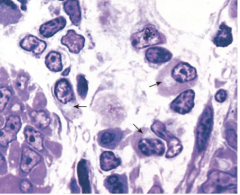
Flattened membrane bound that are enclosed in cistern
Has cis face (entry face) and trans face (exit) -Are well developed in secretory cells (plasma cells - pancreatic acinar cells) CGN - cis golgi network |
|
|
What are coatomer-coated vesicles?
|
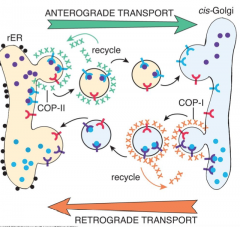
They mediate bidirectional traffic between ER and golgi.
COP-1 - involved in retrograde transport (CGN to rER) COP-2 - anterograde transport (new proteins from rER to CGN) -Also involved in post-translation modificaiton, sorting and packaging |
|
|
What are neutrophil granules?
|
3 types
Azurphilic - primary with peroxidase (kill bacteria), defensins, lysozyme, and enzymes Specific - secondary - lactoferrin (antimicrobial), lysozyme Teritiray - phosphatase, MMP |
|
|
Lysosomes
|
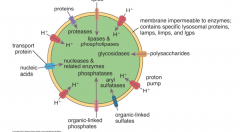
Membrane-enclosed compartments with with 40 hydrolytic enzymes
-Acid hydrolyses (active at only low pH - H+ pumps) - Function is digestion of macromolecules Digest organelles |
|
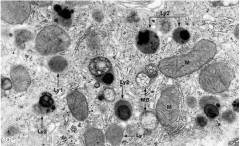
Lysoomes
|

Lysosomes
|
|
|
What is the function of Mannose-6-phosphate?
|
It tags proteins entering from rER into golgi. These are lysomomal hydrolases that are tagged for certain receptor (TGN) to be transported only to lysosomes.
|
|
|
What is Tay-Sachs diseases?
|
Is a lysosomal storage disease that arises from genetic defects of one or more lysodomal hydrolyses.
- results in death - accumulation of gangliosides |
|

What is the pathway of lysosomal digestion?
|
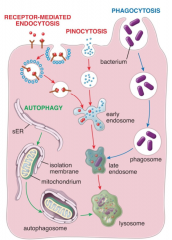
1) Phagocytosis
2) Endocytosis 3) Autophagy - is the major cellular pathway to degrade proteins and organelles in lysosomes. - components are recycled -has an essential role in starvation, cellular differentiation and during cell death and cell aging. |
|
|
What are proteasomes?
|
Is a non-membrane bound protein complex that destroys proteins without using lysosomes.
Proteins are tagged with ubiquitin which are targeted for destruction by proteasome. - inhibitors are used as anti-cancer agents |
|
|
What are inclusions?
|
They are cytoplasmic or nuclear structure that are formed from metabolic products of the cell
Glycogen - non-membrane Lipid - non-membrane - are lipid droplets - store fat - too much --> disease (lipidoses) - occurs more in liver Pigments - membran bound -Lipofuscin - brown-gold pigment (it is a wear and tear pigment) -hemosiderrin - is an iron storage complex and used by breakdown of hemoglobin (spleen) -Melanin - skin pigment |
|
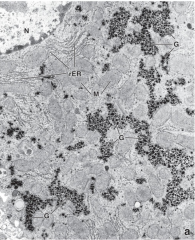
Glycogen Slide
|

|
|

Lipoduscin - sympathetic ganglion
|
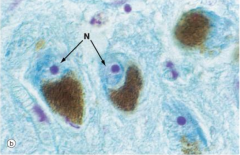
Melanin
|
|
|
Mitochondria structure function and disease
|
ATP production, TCA cycle, B-oxidation of FA
Outer membrane and inner membrane Matrix and intermembrane space -Contain their own DNA and produce their own proteins -own rRNA and tRNA -evolved from aerobic bacteria - engulfed by eukaryotic cells -Maternally derived (from mother) |
|
|
What is MERRF and Leber Hereditary Optic neuropathy?
|
MERRF - myoclonic epilepsy with ragged red fibers
Leber Hereditary optic neuropathy - mutation in mitochondrial gene |
|
|
What is a peoxisome?
|
Are micro bodies - small organ less
They compartmentalize and degrade toxic oxygen and contain CATALSE Also important in fat metabolism - have beta-oxidation of fatty acids. - Also make plasmalogens - needed for myelin Are produced by cytoplasmic ribosomes Zellweger Syndrom - is a defective import of peroxsomal proteins |
|
|
What are actin filaments?
|

Are microfilaments made of protein act
-G-actin and F-actin (ATP dependent) - They are polarized with fast growing (+) end and (-) slow growing end. Function is to anchor and structure and locomotion |
|
|
What is phalloidin?
|
Is a toxin from Amanita phalloides (angle of death of death caps from mushroom_
-Binds to F-actin tightly and inhibits depolymerization, causes liver and kidney failure and death |
|
|
What are cytochalasin?
|
Are other fungal product that block polymerization of actin, they inhibit cell movement and division.
|
|
|
MicroVilli
|
Are cylindrical, membrane bound and have 25-30 micofilaments and crosslinked by villain
|
|
|
Steriocilia
|
Are long microvilli, and are actin filament bundle anchored to terminal web.
- epididymis, ductus deferens and sensory hair |
|
|
What are myosin?
|
Are actin molecular motors,
they generate the force for skeletal muscle contraction (myosin II) Are formed from 2 heavy and 4 light chains. |
|
|
What are intermediate filaments?
|
Are rope like filaments and are structural proteins.
They stabilize cell structure and resist shearing forces. Connect desmosomes and hemidesmosomes and are essential for integrity of cell-cell junctions. |
|
|
What are the 6 classes of intermediate filaments?
|
1&2: Keratins -
3: Vimentin and Vimentin like: is mesenchymal cells (desmin - muscle cells) 4: Neurofilaments - in neurons (axons) support 5: Lamins - nuclear lamina 6: Beaded Filaments - lens specific |
|
|
What are centrioles, centrosomes?
|
Are 9-triplets of microtubules around a central axis
Form centrosome and for assembly of cilia and flagella. Centrosomes - is large protein with microtubules and help anchor the nuclease at negative (-) end. |
|
|
What are microtubules and what are MAPS?
|
Contain alpha and beta protein subunits.
Are polar (-) and (+) end - extend out. Function for intracellular cell transports, cell motility, mitotic spindle. Is GTP dependent Have MAPs (microtubule associated proteins) -which are Tau proteins and abundant in CNS - linked to Alzheimer's Disease |
|
|
What is the affect of Colchicine?
|
Is an anti-cancer compound that prevents polymerization of microtubules by binding to tubulin molecules.
Results in programmed cell death |
|
|
What is the affect of Taxol?
|
Is another anticancer drug that stabilizes and prevents mictoubule disassembly - arrests mitosis.
Leads to programmed cell death. |
|
|
What are the microtubule molecular motor movies?
|
Kinesin Family:
- move toward the positive (+) end and have binding sites for vesicles, organelles or mictotubule Dynein: -move to negative end -have cytoplasmic and axonemal branches -Are ATP dependent -are fastest |
|
|
What are cilia?
|
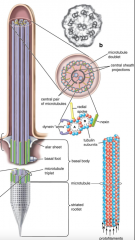
Are microtubule base
- Have 9-2 microtubule arrangement - Pair of dyenin arms -move fluid and particles Primary Cilia - antennae like (9+0) and anchored by basal body Has sensory role -photoreceptors - outer segment of rods -chemoreceptors - odor detection -mechanoreceptor - primary cilia (defect results in Polycystic Kidney Disease) |
|
|
Cell Motility
|
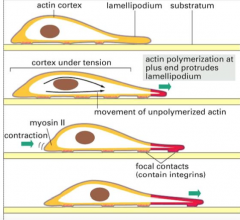
Protrusion - actin structures pushed out
Attachment - actin cytoskeleton connect to plasma membrane Contract - cell contracts |
|
|
What are filopodia, lamellipodia and pseudopodia?
|
Are all actin organization filaments responsible during cell motility.
|
|
|
What is actin polymerization?
|
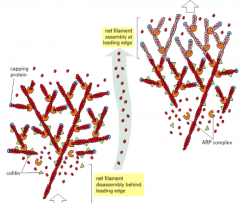
Actin filaments with (+) facing forward, (-) end is attached to sides of actin filaments . Disassembles at rear and assembles at front. - treadmill affect
|
|
|
What are Rho, Rac and CDC42?
|
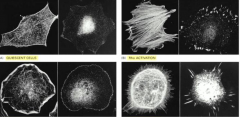
Are specific family proteins that have to do with cell motility.
Rho - bundles of actin filaments with myosin II Rac - actin polymerization and lamellipodia CDC42 - actin polymerization and filopodia |
|
|
What is the process of neutrophil extravasation?
|
Inflammation (histamin) promotes selectin receptors on endothelial cells, neutrophils roll ong surface and chemokines express integrins on these leukocytes which bind to receptors on cell surface.
Then move into connective tissue via MMP. |

